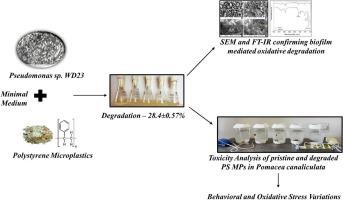假单胞菌WD23对聚苯乙烯微塑料的生物降解:用淡水蜗牛Pomacea canaliculata评价毒性
Q1 Environmental Science
引用次数: 0
摘要
研究了石油烃降解假单胞菌WD23对聚苯乙烯微塑料(PS MPs)的降解作用及对小管Pomacea canaliculata的毒性评价。100 mg/L PS MPs暴露于假单胞菌sp. WD23 42天,导致体重减轻28.40±0.57%,符合一级动力学,速率常数和半衰期分别为0.0073天和94.95天。扫描电镜和傅里叶变换红外光谱分析显示细菌生物膜的存在,平滑,孔洞形成,证实氧化降解。通过行为、死亡率、酶促胁迫和非酶促胁迫反应分析了100和200 mg/kg原生态和降解PS MPs对小管Pomacea canaliculata的比较毒性。与原始PS MPs接触,过氧化氢酶(0.0095 ~ 0.0113 mmol/(min·mg蛋白))和自由基清除活性(73.68 ~ 78.96%)的反应时间延长。暴露于降解的PS MPs中产生轻微的过氧化氢酶(0.0029-0.0032 mmol/(min·mg protein))和中等的自由基清除活性(63.15 - 65.78%)。本文章由计算机程序翻译,如有差异,请以英文原文为准。

Biodegradation of polystyrene microplastics by Pseudomonas sp. WD23: Toxicity assessment using freshwater snail Pomacea canaliculata
This study presents degradation of polystyrene microplastics (PS MPs) by petroleum hydrocarbon degrading Pseudomonas sp. WD23 and toxicity assessment on Pomacea canaliculata. Exposure of 100 mg/L PS MPs to Pseudomonas sp. WD23 for 42 days, led to 28.40 ± 0.57 % weight reduction, following first order kinetics with rate constant and half-life of 0.0073 day−1 and 94.95 days. Scanning electron microscopy and Fourier transform infrared spectrometry analysis revealed bacterial biofilm presence, smoothening, hole formation with confirmed oxidative degradation. Comparative toxicity of 100 and 200 mg/kg sediment of pristine and degraded PS MPs on Pomacea canaliculata was analyzed by behavior, mortality, enzymatic and non-enzymatic stress responses. Contact with pristine PS MPs caused increased reaction time with marked catalase (0.0095–0.0113 mmol/(min·mg protein)) and radical scavenging activity (73.68–78.96 %). Exposure to degraded PS MPs yielded slight catalase (0.0029–0.0032 mmol/(min·mg protein)) and moderate radical scavenging activity (63.15–65.78 %).
求助全文
通过发布文献求助,成功后即可免费获取论文全文。
去求助
来源期刊

Bioresource Technology Reports
Environmental Science-Environmental Engineering
CiteScore
7.20
自引率
0.00%
发文量
390
审稿时长
28 days
 求助内容:
求助内容: 应助结果提醒方式:
应助结果提醒方式:


